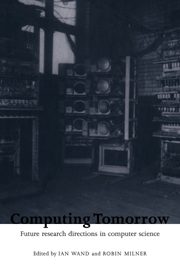Book contents
- Frontmatter
- Contents
- Preface
- Contributors
- 1 The Complexity of Algorithms
- 2 Building Novel Software: the Researcher and the Marketplace
- 3 Prospects for Artificial Intelligence
- 4 Structured Parallel Programming: Theory meets Practice
- 5 Computer Science and Mathematics
- 6 Paradigm Merger in Natural Language Processing
- 7 Large Databases and Knowledge Re-use
- 8 The Global-yet-Personal Information System
- 9 Algebra and Models
- 10 Real-time Computing
- 11 Evaluation of Software Dependability
- 12 Engineering Safety-Critical Systems
- 13 Semantic Ideas in Computing
- 14 Computers and Communications
- 15 Interactive Computing in Tomorrow's Computer Science
- 16 On the Importance of Being the Right Size
- References
- Index
15 - Interactive Computing in Tomorrow's Computer Science
Published online by Cambridge University Press: 10 December 2009
- Frontmatter
- Contents
- Preface
- Contributors
- 1 The Complexity of Algorithms
- 2 Building Novel Software: the Researcher and the Marketplace
- 3 Prospects for Artificial Intelligence
- 4 Structured Parallel Programming: Theory meets Practice
- 5 Computer Science and Mathematics
- 6 Paradigm Merger in Natural Language Processing
- 7 Large Databases and Knowledge Re-use
- 8 The Global-yet-Personal Information System
- 9 Algebra and Models
- 10 Real-time Computing
- 11 Evaluation of Software Dependability
- 12 Engineering Safety-Critical Systems
- 13 Semantic Ideas in Computing
- 14 Computers and Communications
- 15 Interactive Computing in Tomorrow's Computer Science
- 16 On the Importance of Being the Right Size
- References
- Index
Summary
Introduction
Three decades ago the Sketchpad system was presented to the public, an event that did much to put interactive systems on the computing agenda (Sutherland, 1963). I remember the event well. The Sketchpad film, shown at a conference I was attending in Edinburgh, ran for only about ten minutes, but this was quite long enough for me to make up my mind to abandon my faltering career as a control-systems engineer and seek to become a computer scientist. I have never regretted that decision.
Thirty years later, interactive systems have established themselves across society, in a fashion that I and my 1960s contemporaries never dreamed of. Today we interact with computers in TV sets, telephones, wristwatches, ticket machines, kitchen scales, and countless other artefacts. The range of human activities supported by interactive technology is still expanding, apparently without limits. Demand for interactive systems and artefacts has fuelled the growth of today's computer industry, which now treats interactive computing as the mainstream of its business. Thus a technology that was startlingly radical in 1963 has become part of normal practice today.
My concern here is not with the amazing change, during three decades, in the way computers are used, but with a disappointing lack of change in the ways computing is taught and computer science research is carried out. I am concerned that interactive systems, having gained a place on the computing agenda in 1963, are still little more than an agenda item as far as computer science is concerned. While interactive computing now represents the mainstream of the industry's business, it plays hardly any part in the mainstream of computer science. It continues to be treated as a special case.
- Type
- Chapter
- Information
- Computing TomorrowFuture Research Directions in Computer Science, pp. 295 - 320Publisher: Cambridge University PressPrint publication year: 1996



